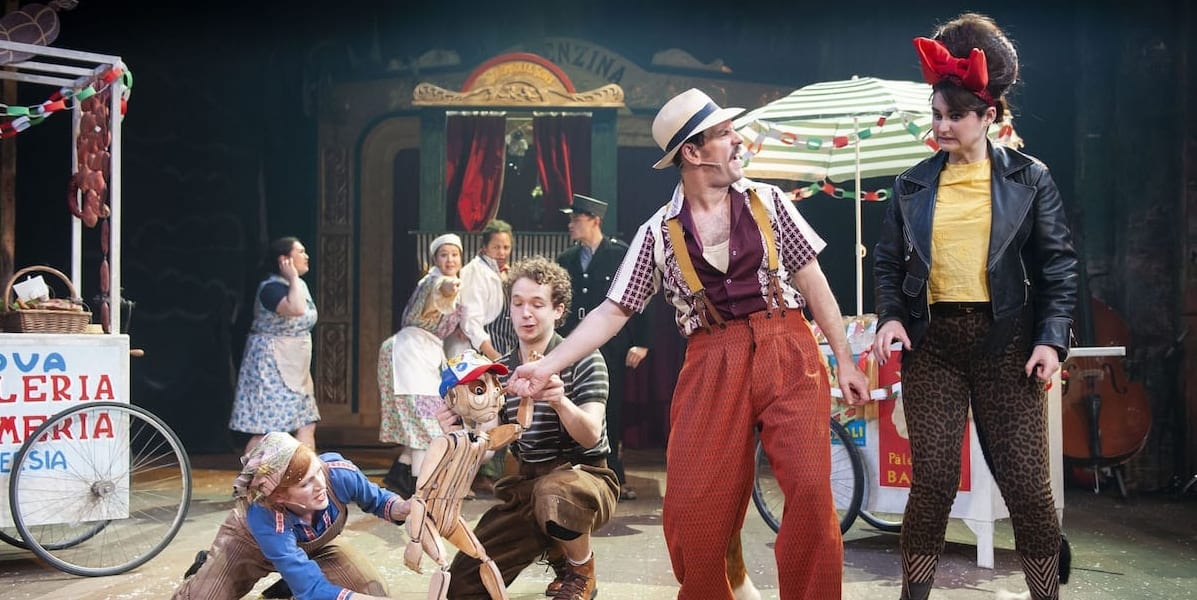To date, the most popular Italian literary text to be translated worldwide is not by Dante, Boccaccio or Petrarch, but by Carlo Collodi: his Pinocchio which was first published in 1883. Pinocchio’s long nose has become such an intercultural symbol to represent a liar that, not only was it used in the iconic animation film by Walt Disney, but it has since become a common theme in popular journalism and even in everyday emojis. Adaptations of this popular children’s novel come in all shapes and sizes, and this stage version of Pinocchio at Glasgow’s Citizens’ Theatre at the Tramway, written by Robert Alan Evans, brings together audiences in Scotland of all ages.
The use of live music performed by the different actors, the setting, and incredible fast and fascinating second act, particularly the scene with the whale, are incredible and no less than breath-taking. The acting is on point: the performers switch in and out of roles in a blink of an eye, showing the excellent craftsmanship in their art, and the nod to the Commedia dell’arte works particularly well with the different spotted costumes for the puppets (designed by Rachael Canning). The wooden puppet, also brilliantly designed by Canning (led by Liam King and partly directed by Elisa De Grey), flawlessly integrates with his fellow human characters, such as his “palls” at school, and has a moving relationship with his father Gepetto (performed by Gary Lilburn), his father’s companion Maria (interpreted by Elisa De Grey), and his loyal ally the Cricket (performed by Helena Katamba).
For me, what hinders this production is the use of different accents and the implications this has on our future generation sitting in the audience. First of all, Gepetto adopts an Italian accent. A non-Italian performing an Italian accent always risks sounding a bit like a parody (in line with the kind of Mediterranean accents employed by brilliant non-native actors, such as Andrew Sachs’s Manuel in Fawlty Towers). At the same time, this throws up some really interesting questions about the difficulties in transposing Italian accents to the stage. Moreover, the poor but creative Gepetto is the only character to employ an Italian accent, whereas the baddies, all also excellently performed, such as the wealthy puppet-master Florenza (played by Irene Allan), together with the Fox (interpreted by Andy Clark) and the Cat (performed by Stephanie Payne), as well as the teacher and police authority, employ an English accent. Again, this sort of code-switching raises more interesting questions about the kind of message theatre in general is trying to convey about social class and different cultural associations. Indeed, the implicit racial stereotyping underpinning the production is unmissable: with its pasta-making market stalls (which are not typical in Italy) or its incorrect use of Italian tailored to convince British audiences into perceiving it as real Italian: for instance, the use of the “pappa”, that is frequently used in the show to allude to the special father-son bond, has a very different sound to the actual Italian word for “Father” – papà, which is much more short and staccato.
Despite this, this spectacular production translates Collodi’s timeless and ageless story through an imaginative, dynamic, and creative lens. If stories stand the test of time owing to all its many variations and adaptations, then this retelling of the popular tale certainly adds to the work’s long literary afterlife.

